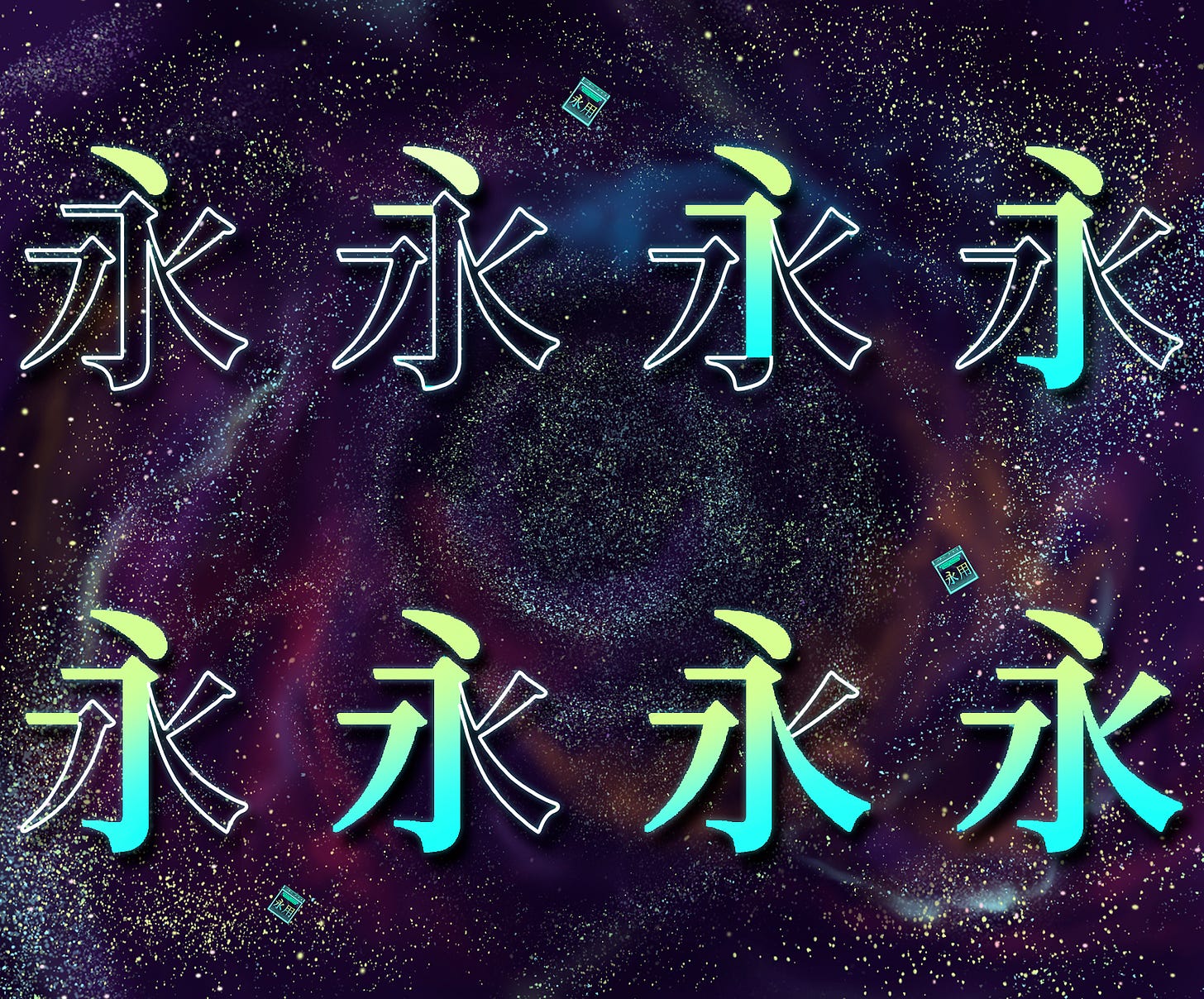Block 1 of 1
Page: Curated Book | Kingdom of Characters: The Language Revolution That Made China Modern by Jing Tsu (2022) → BUY BOOK
Section: Introduction
Kindle Pages: xi - xix
The Cultural Significance of Chinese Characters
In the introduction, Tsu delves into the deep reverence China holds for its writing culture, emphasizing its unparalleled historical continuity and cultural significance. Chinese, the world's oldest continuously used language, is spoken by over 1.3 billion people and has maintained a largely unchanged written form for more than 2,200 years. This stability contrasts with the evolution of the Roman alphabet, which finalized its set of twenty-six letters only in the sixteenth century.
Image: Artistic representation of traditional Chinese architecture with two figures overlooking an intricate landscape featuring yin-yang symbol, Chinese characters, and mythical scenery, encapsulating China's cultural heritage.
YSyncX Illustrations: 1) Chinese Culture, Yong: Eternity - Everlasting - Forever - Permanence, and Calligraphy Cubes in the foreground of the image. 2) Two individuals from YSyncX observing different aspects of Chinese cultural heritage in the background.
Highlighting the cultural significance of calligraphy in China, Tsu notes, "Chinese heads of state are probably the only political leaders in the world who can still be seen demonstrating their cultural prowess at official occasions" by writing with an ink brush. Leaders such as Deng Xiaoping, Hua Guofeng, Hu Jintao, Xi Jingping, and Mao Zedong, with his calligraphy still featured on the masthead of the People's Daily, exemplify this tradition.
The practice of calligraphy by China's leaders serves multiple symbolic functions: it legitimizes their authority, connects them to a longstanding intellectual tradition, and reinforces the importance of cultural and scholarly pursuits that have defined the ruling class since ancient times. Tsu argues that in the Chinese context, literacy transcends mere functional ability to read and write. It signifies a deep engagement with the classical wisdom of ancient times, a medium for self-cultivation and personal expression, and a marker of elite status.
Tsu points at the Western curiosity about the Chinese language. Spanning over four centuries, this fascination with Chinese was not merely academic; it reflected a deeper quest to understand a civilization that developed a complex writing system entirely outside the influence of Christendom.
Tsu also says that the Opium War of 1839 to 1842, marked the beginning of a new era for China, one fraught with crises and confrontations with the Western world. These conflicts, which positioned China in a seemingly inferior stance, sparked fears over the survival of the Chinese script in an age dominated by Western scientific advancements and new communication technologies like the telegraph. Despite these challenges, the Chinese language remained a cornerstone of the nation's cultural identity, so deeply ingrained in China’s history and institutions that the thought of abandoning it was unfathomable. Intellectuals, teachers, engineers, and reformers at all levels of society began a collective endeavor to adapt the Chinese script to the demands of the modern world, striving to put it on equal footing with Western alphabetic languages.
A Personal Journey from Chinese to English
The struggle of bridging the vast divide between the Chinese script and the Western alphabet is not merely academic but deeply personal, as Tsu illustrates through the recounting of their own family's journey from Taiwan to the United States. She describes the initial excitement and subsequent challenges of learning English, a language with only twenty-six letters, a stark contrast to the thousands of characters in Chinese.
Tsu reflects on the physical and mental adjustments required to switch from Chinese to English, from the way one holds a writing instrument to the direction of writing. However, despite the relative ease of learning the alphabet, Tsu expresses a deep sense of alienation from the Western script, describing it as "strangely empty of expressiveness" compared to the tonal richness of Chinese.
Characters, Strokes, and Tones
There are six basic properties that set the Chinese script apart from the Roman alphabet. One of them is the nature of Chinese characters, which Tsu describes as "a written unit that bears meaning," roughly equivalent to a word in English but also more nuanced, as characters often appear in pairs to convey a full sense. Characters are known by various names such as “logographs, pictographs, semantograms, pictograms, sinographs, and—what the Chinese call them—hanzi (“Han characters,” named after the dynasty that first standardized them).” Tsu also clarifies a common misconception, noting that "while written Chinese was for a long time described as pictographs...no more than 3 percent of characters are historically pictorial or properly ideographic."
Image: Stylized cosmic background with multiple glowing Chinese characters '永' symbolizing eternity, amidst a starry nebula, reflecting the timelessness and expansive nature of the Chinese language.
YSyncX Illustrations: The background features YSyncX stardust and cubes
Tsu explains that characters are made up of strokes, written in a specific order, with eight “considered fundamental." This meticulous approach to writing is exemplified through the character 永 ("eternity"), which encompasses all eight fundamental strokes. She also discusses the concept of radicals within characters, which serve as a means to organize and categorize them, similar to how dictionaries are structured.
Chinese is also a tonal language, which means different tones can have different meanings between characters that otherwise share the same syllable and pronunciation. This aspect of the language adds another layer of complexity, distinguishing it further from Western languages.





